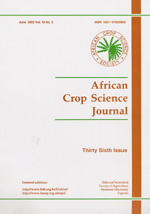
|
African Crop Science Journal
African Crop Science Society
ISSN: 1021-9730
EISSN: 1021-9730
Vol. 22, No. 4, 2014, pp. 257-265
|
 Bioline Code: cs14024
Bioline Code: cs14024
Full paper language: English
Document type: Research Article
Document available free of charge
|
|
|
African Crop Science Journal, Vol. 22, No. 4, 2014, pp. 257-265
| fr |
Morojele, M.E. & Mbewe, D.N.M
Résumé
Le haricot commun ( Phaseolus vulgaris

L.) est une légumineuse à grande variabilité morphologique, ceci se démontre par la grande différence observée au niveau des modes de croissance, pigmentation, appareil floral, loges, gousses, graines, phénologies et plusieurs autres caractères. Cette étude visait à distinguer, sur la base de profil protéique, les variétés de haricot commun cultivées dans la région sud de l’Afrique. Une collection de 42 accessions obtenue de Lesotho, République Sud-Africaine et Zambie a été utilisée à cet effet. L’électrophorèse sur gel de sodium dodécyl sulfate polyacrylamide a été utilisée pour séparer les extraits de résidu protéique et développer des électrophorégrammes à partir desquels les bandes ont été identifiées, afin de générer une matrice de 1 ou 0. Des analyses typologiques et analyse de correspondance ont été effectuées sur les données collectées. Parmi les 10 niveaux de correspondance générés à partir des 17 caractères étudiés, seuls les trois premiers niveaux de correspondance qui constituent 54,57% de la variation totale ont été considérés dans l’analyse. Le premier, le second et le troisième niveau de correspondance, expliquent respectivement 23,23 ; 16,80 et 14,54% de la variation totale. Trente-huit variétés individuelles et sept accessions génétiquement proches ont été identifiées, tandis que trois variétés et trois autres accessions n’ont pas pu être identifiées. L’étude a montré une grande variabilité entre les accessions de haricot commun. Les accessions telles que winter-green, nordak, olathe, tanz1, lazy-house wife, zm 3749b, zm 3749a, zm 4517b, zm4517c, zm 4512 and zm 4527 étaient aberrantes. L’analyse typologique a montré quelques accessions présentant de 30 à 85% de niveau de similarité.
Mots Clés
Analyse typologique; Lesotho; Phaseolus vulgaris
|
| |
| en |
CHARACTERISATION OF COMMON BEAN GENOTYPES BASED ON STORAGE PROTEIN PROFILES
Morojele, M.E. & Mbewe, D.N.M
Abstract
Common bean ( Phaseolus vulgaris

L.) is a morphologically diverse leguminous crop as evidenced by a great variation in growth habits, pigmentation, flowers, locules, pods, seed, phenology and many other characters. The study was conducted to distinguish common bean genotypes grown in Southern Africa sub-region based on storage protein profiles. A collection of 42 genotypes were obtained from Lesotho, Republic of South Africa and Zambia. Sodium Dodycel Sulphate Polyacrilamide Gel Electrophoresis was used to separate extracted residual protein and develop electrophoregrams from which bands were scored, generating a matrix of 1 or 0. Correspondence and cluster analysis were performed using the dataset. Out of 10 correspondence scores generated from 17 characters, only the first three which constituted 54.57% of the total variation and were considered for analysis. The first, second and third correspondent scores accounted for 23.23, 16.80 and 14.54%, respectively. Thirty-eight individual genotypes and seven intra-accessions were distinguished, while three genotypes and three accessions were indistinguishable. The study showed a wide variation among the common bean genotypes. Cultivars such as winter-green, nordak, olathe, tanz1, lazy-house wife, zm 3749b, zm 3749a, zm 4517b, zm4517c, zm 4512 and zm 4527 were outliers. Cluster analysis showed that some cultivars started to show difference at 30 up to 85% level of similarity.
Keywords
Cluster analysis; Lesotho; Phaseolus vulgaris
|
| |
© Copyright 2014 - African Crop Science Journal
|
|
